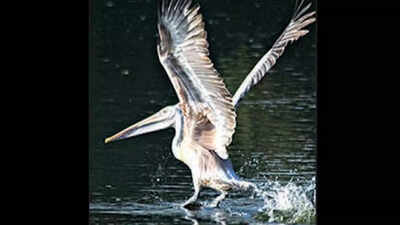- News
- City News
- mysuru News
- Migration path: Mysuru pelicans to be geo-tagged
Migration path: Mysuru pelicans to be geo-tagged
Migration path: Mysuru pelicans to be geo-tagged

A study will be conducted to learn about their habitat
MYSURU: After pelicans from Kokkrebellur in Mandya district were geo-tagged by scientists of Wildlife Institute of India, Dehradun, to track their flight path and study migratory patterns, Mysuru pelicans too will be geo-tagged.
A study will be conducted to learn about their habitat as over 10,000 spot-billed pelicans are spotted in and around Mysuru.
Over the last few years, many spot-billed pelicans have been visiting not just Kokkerbellur Bird Conservation Centre, but also Ranganathittu bird sanctuary in Srirangapatna taluk, Kukkarahalli and Lingambudhi in Mysuru as well as Madiwala lake in Bengaluru.
The migratory birds usually arrive during winter — November and December — from north India and other countries to breed, and fly back when summer begins in March.
Forest department sources said 79,793 migratory birds of 253 species, including spot-billed pelicans, were spotted in and around Mysuru in 2015. As many as 15,437 birds of 179 species in 2016, 54,057 birds of 221 species in 2017, 20,677 birds of 187 species in 2018, 45, 986 birds of 219 species in 2019 were seen.
A large number of species of migratory birds were spotted in and around Mysuru in 2015, 2018, 2019 but declined in 2016, 2017 and 2020.
As the region has received abundant rain, the forest department is expecting a large number of migratory birds this season. With Kokkerebellur recording deaths of migratory birds, researchers from WWI and the forest department decided to geo-tag these birds to pinpoint the exact cause of their deaths.
When pelicans come here, they roost, lay eggs, feed the newborns and fly away with their young ones. Tagging them will also give information about where they come from, where they go and their life cycle, said Tanuja DH, an avid bird watcher.
Rs 1.5L per tag
Deputy conservator of forests, Mysuru wildlife division, R Karikalan said his department has already placed an order with WWI for geo-tagging equipment. Each tag costs around Rs 1.5 lakh, he said.
The solar-based geotags imported from Germany have a life of at least eight years. They are expected by December-end or January-end. Once the department receives tags, it will be inserted into the wings of migratory birds and their readings can be monitored from the nearest mobile towers.
A study will be conducted to learn about their habitat as over 10,000 spot-billed pelicans are spotted in and around Mysuru.
Over the last few years, many spot-billed pelicans have been visiting not just Kokkerbellur Bird Conservation Centre, but also Ranganathittu bird sanctuary in Srirangapatna taluk, Kukkarahalli and Lingambudhi in Mysuru as well as Madiwala lake in Bengaluru.
The migratory birds usually arrive during winter — November and December — from north India and other countries to breed, and fly back when summer begins in March.
Forest department sources said 79,793 migratory birds of 253 species, including spot-billed pelicans, were spotted in and around Mysuru in 2015. As many as 15,437 birds of 179 species in 2016, 54,057 birds of 221 species in 2017, 20,677 birds of 187 species in 2018, 45, 986 birds of 219 species in 2019 were seen.
A large number of species of migratory birds were spotted in and around Mysuru in 2015, 2018, 2019 but declined in 2016, 2017 and 2020.
As the region has received abundant rain, the forest department is expecting a large number of migratory birds this season. With Kokkerebellur recording deaths of migratory birds, researchers from WWI and the forest department decided to geo-tag these birds to pinpoint the exact cause of their deaths.
When pelicans come here, they roost, lay eggs, feed the newborns and fly away with their young ones. Tagging them will also give information about where they come from, where they go and their life cycle, said Tanuja DH, an avid bird watcher.
Rs 1.5L per tag
Deputy conservator of forests, Mysuru wildlife division, R Karikalan said his department has already placed an order with WWI for geo-tagging equipment. Each tag costs around Rs 1.5 lakh, he said.
The solar-based geotags imported from Germany have a life of at least eight years. They are expected by December-end or January-end. Once the department receives tags, it will be inserted into the wings of migratory birds and their readings can be monitored from the nearest mobile towers.
FacebookTwitterLinkedinEMail
Start a Conversation
end of article
Quick Links
Delhi Air PollutionDelhi TemperatureChennai WeatherBangalore TemperatureCovid vaccination centres in DelhiCoronavirus in DelhiRTPCR test in GurgaonHyderabad RainPollution level in BangaloreDelhi SmogDelhi TemperatureNoida AQIGurgaon AQI todayFire in MumbaiMumbai RainsCovid 19 RT PCR Test in NoidaDelhi AQI todaySrinagar encounter

